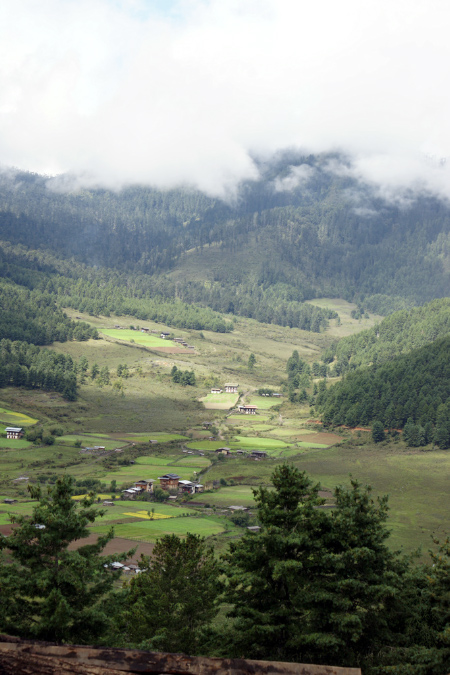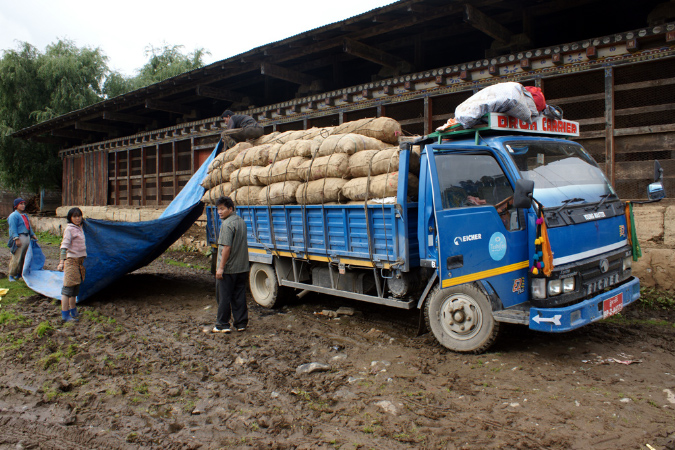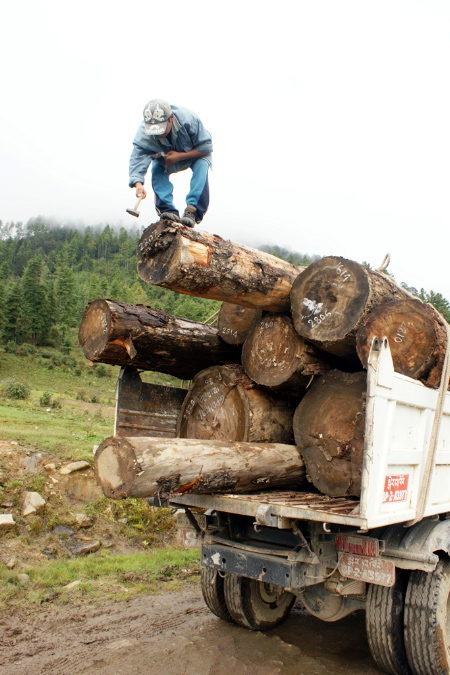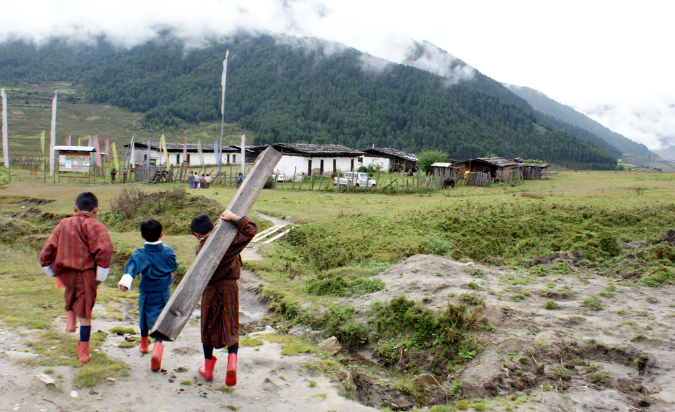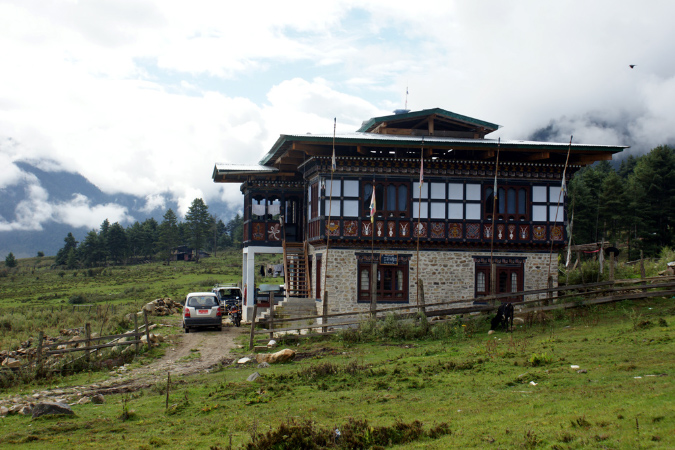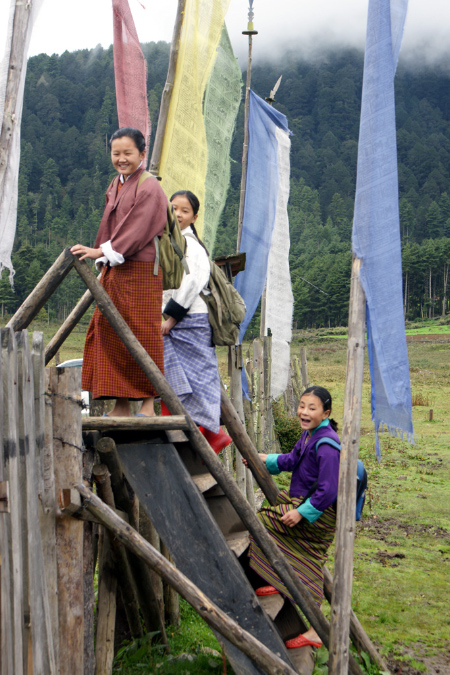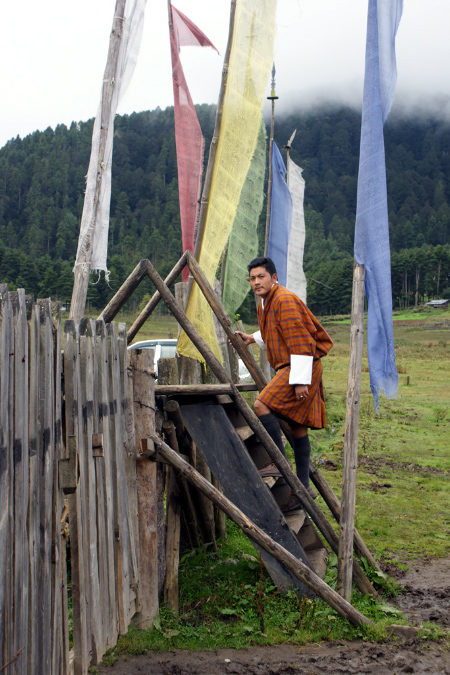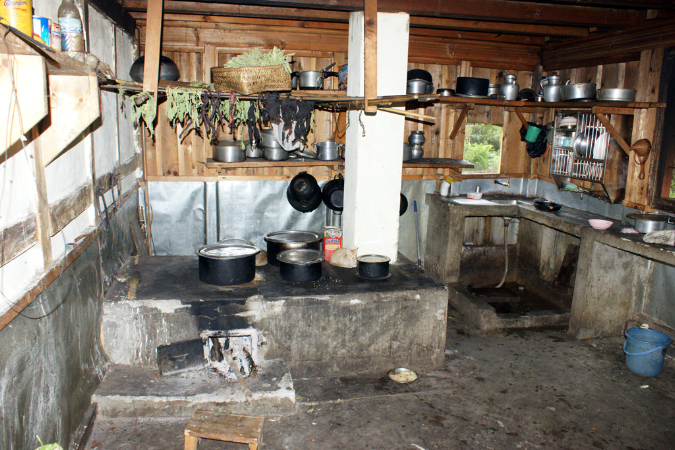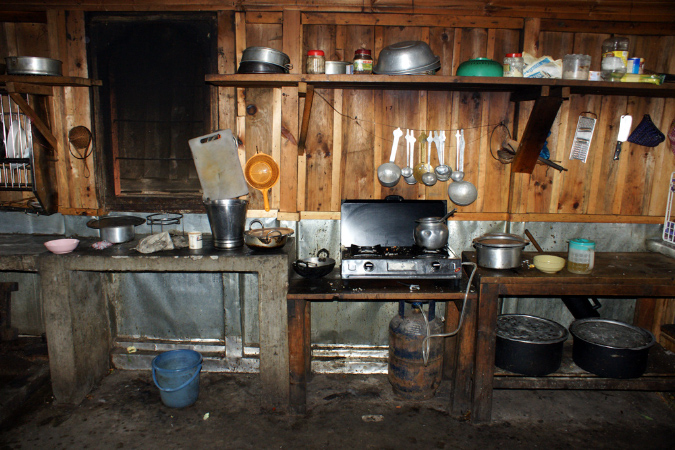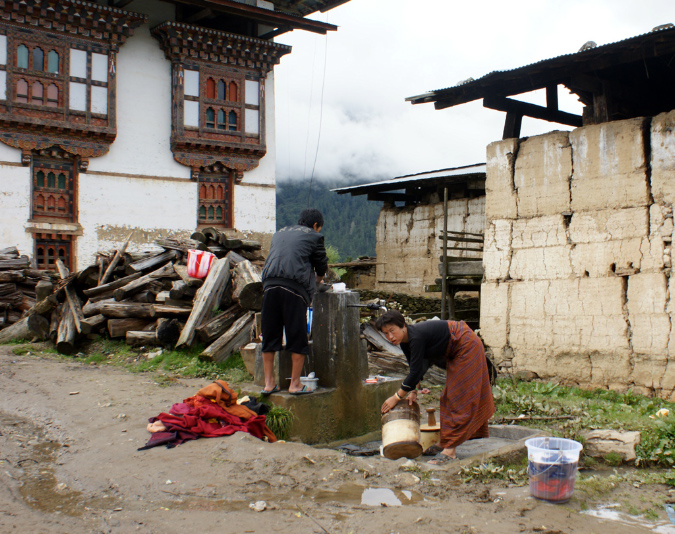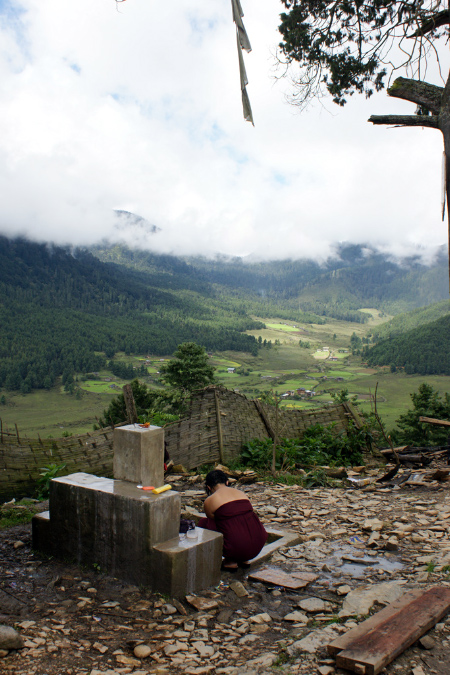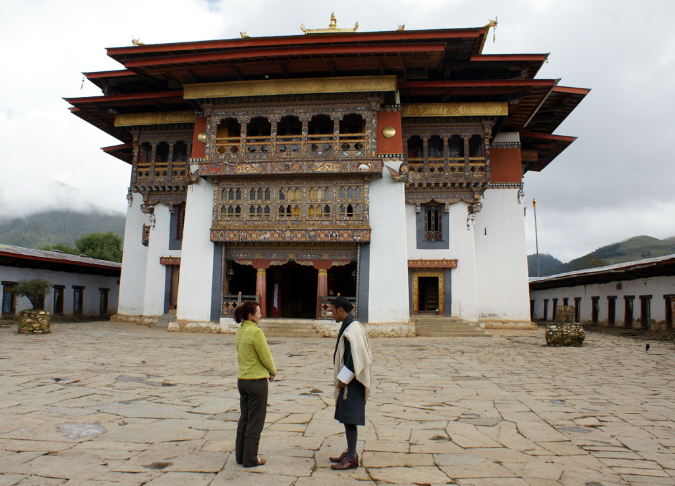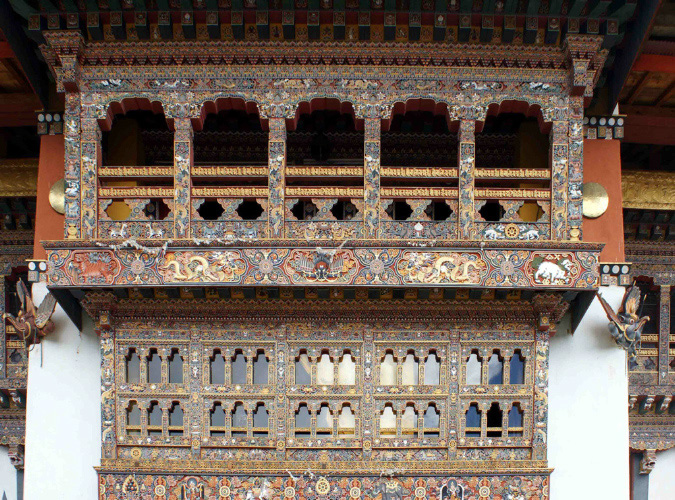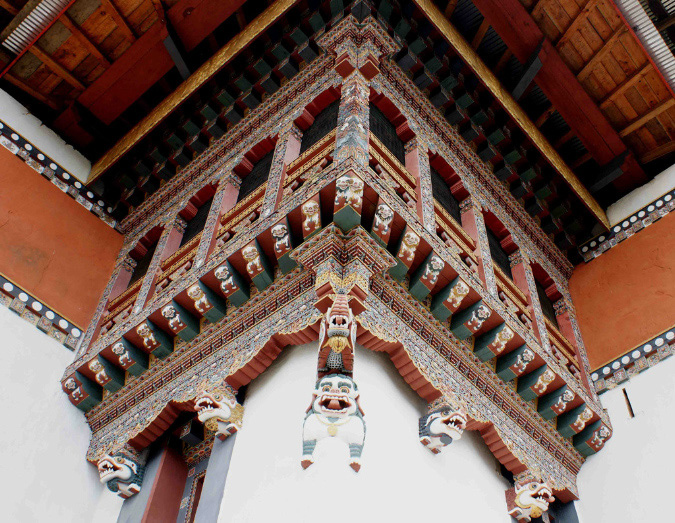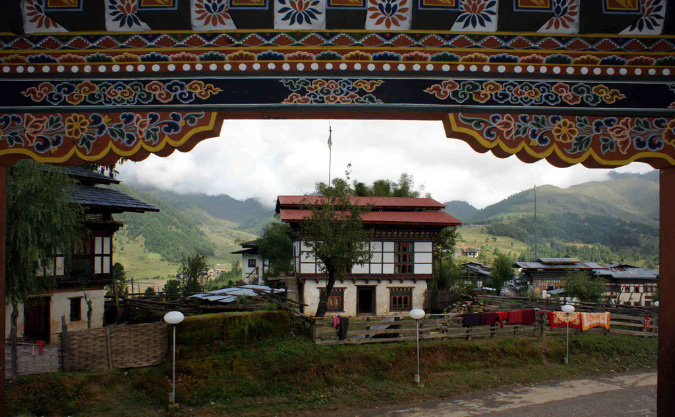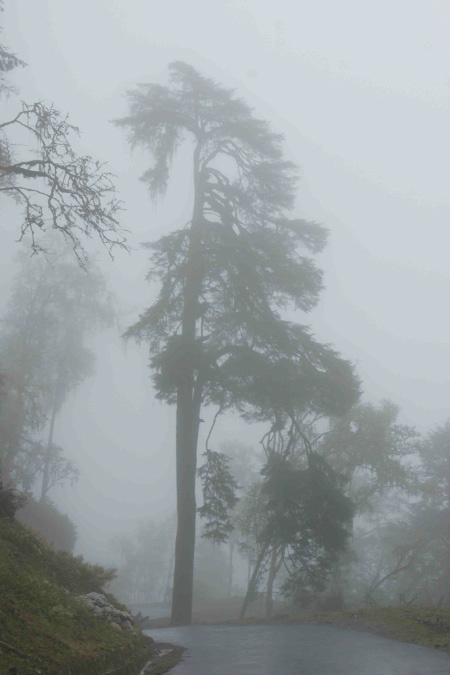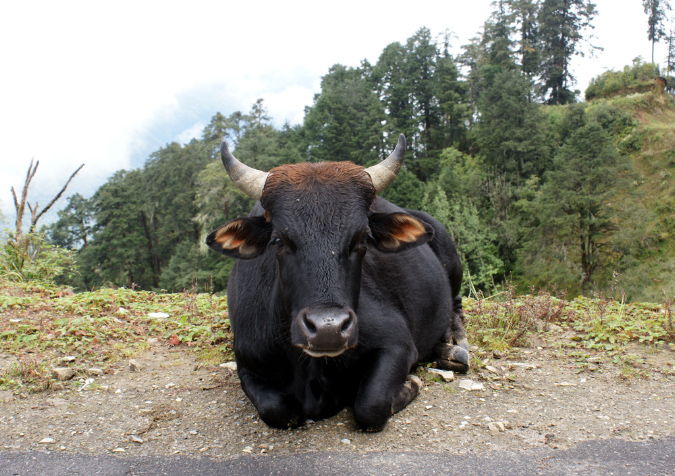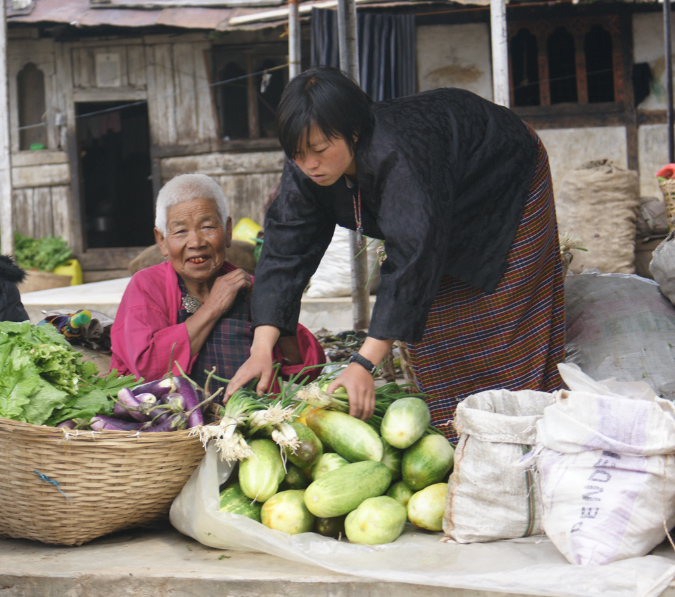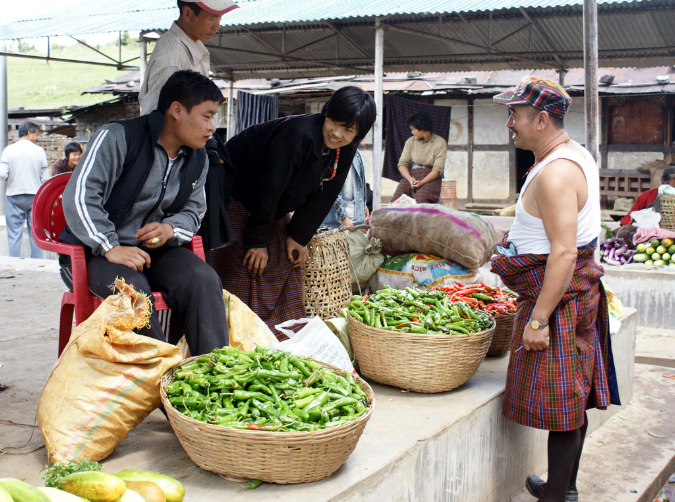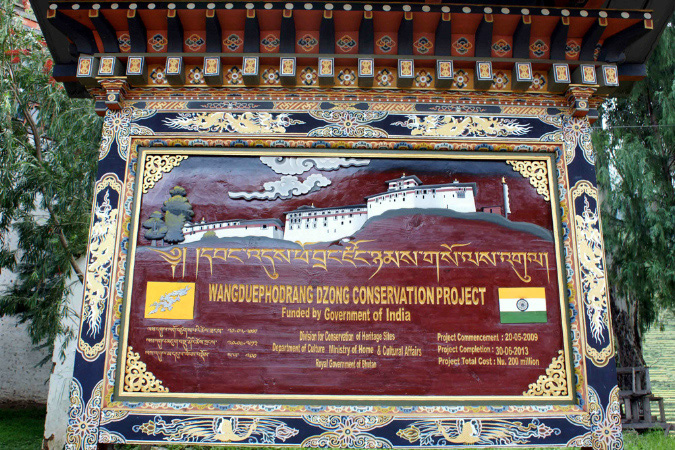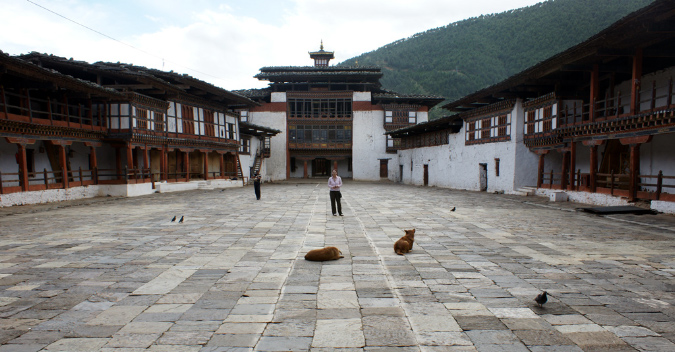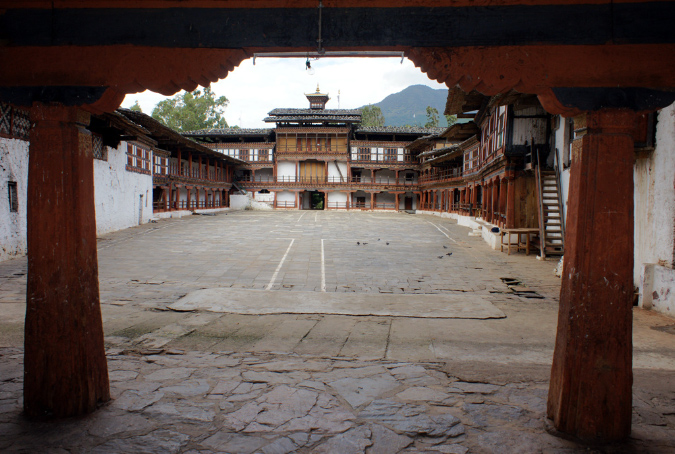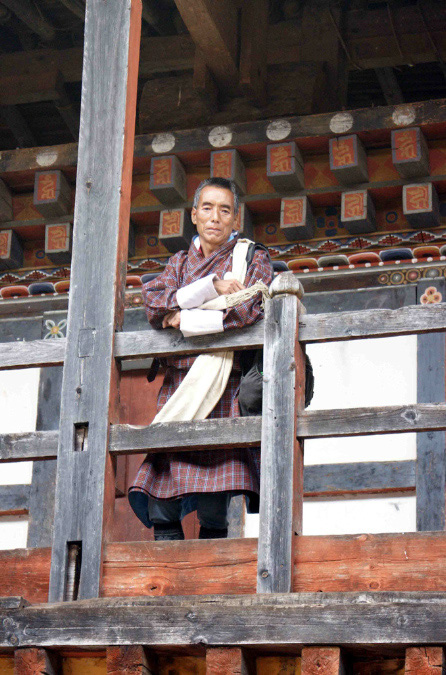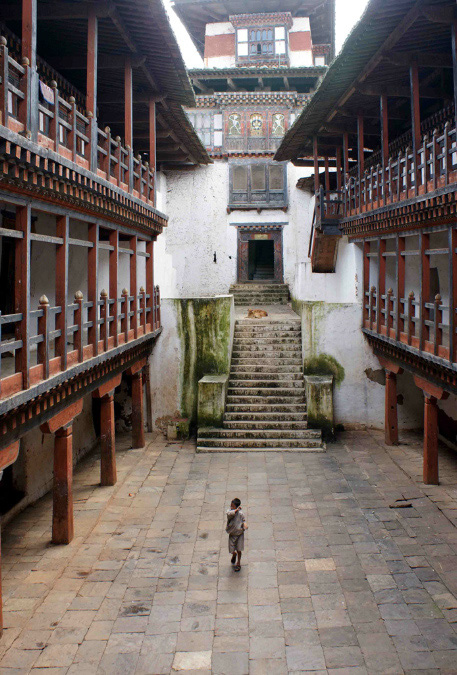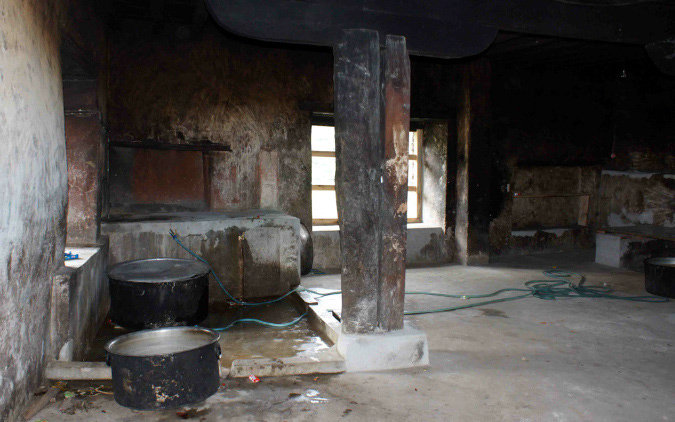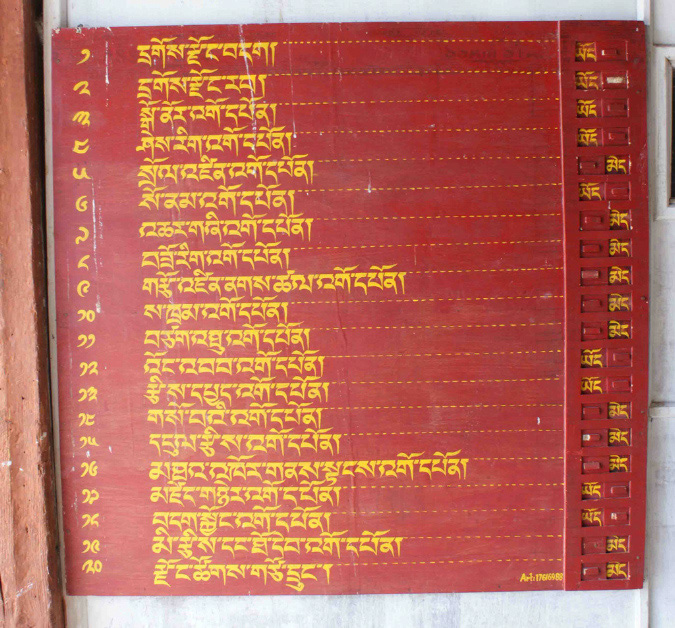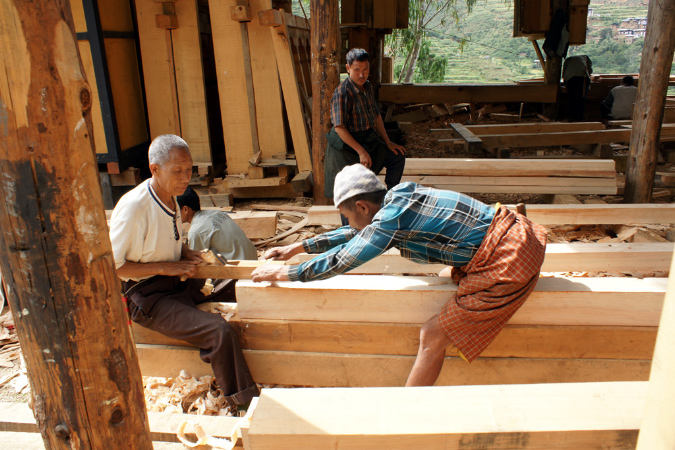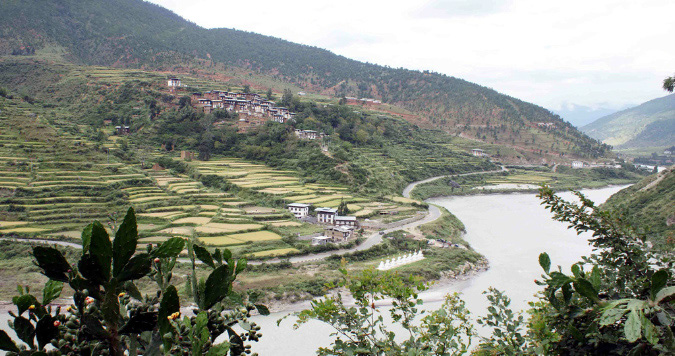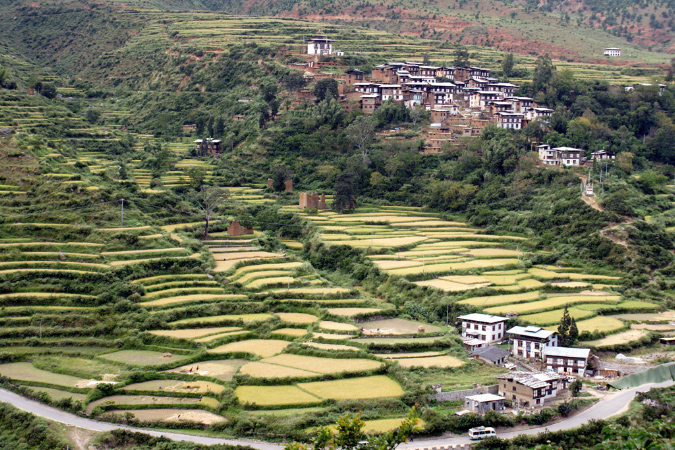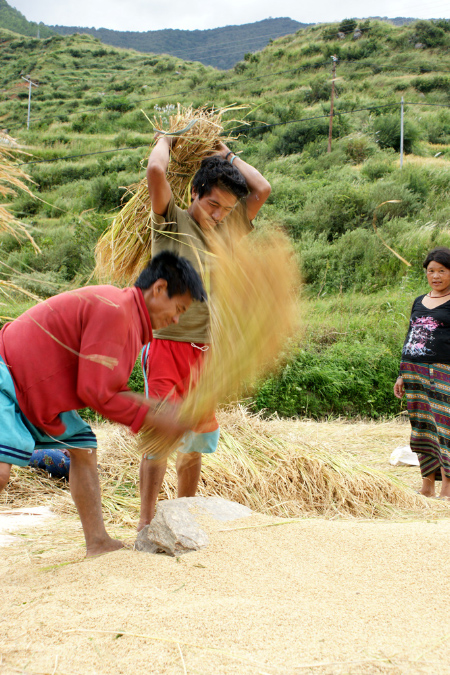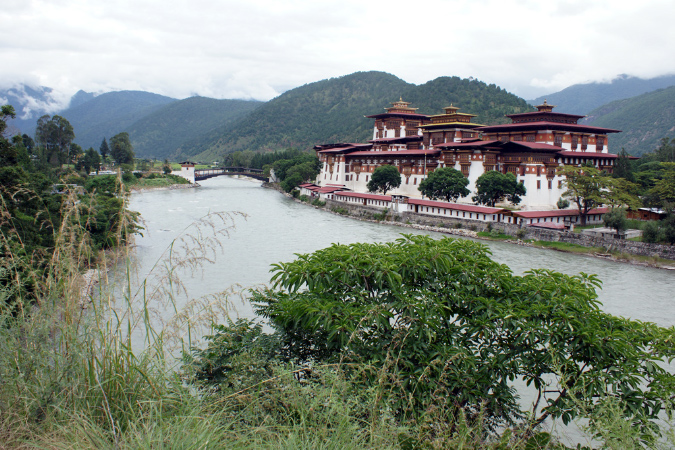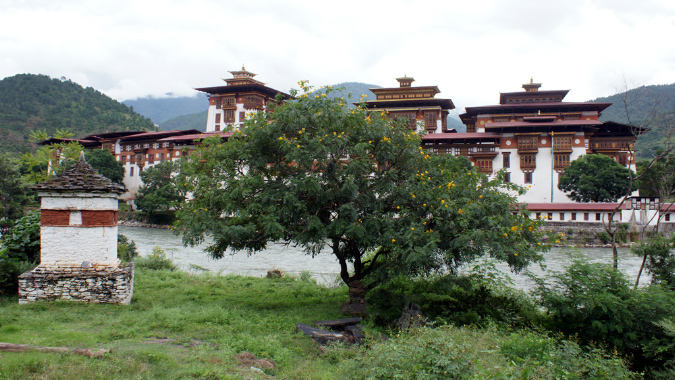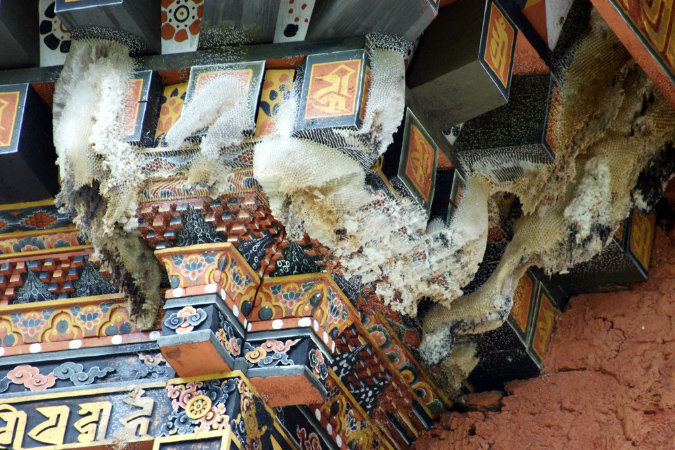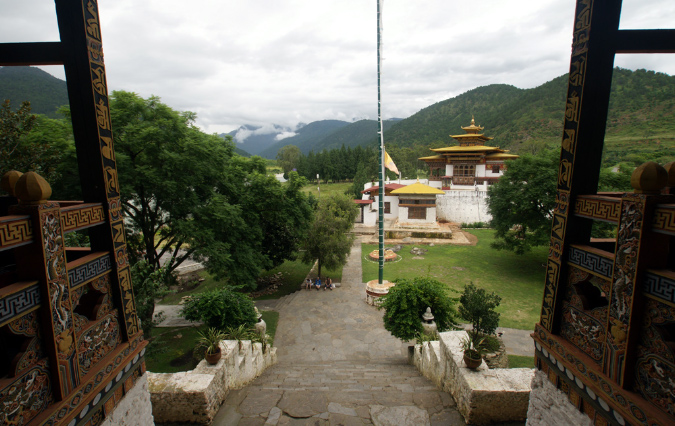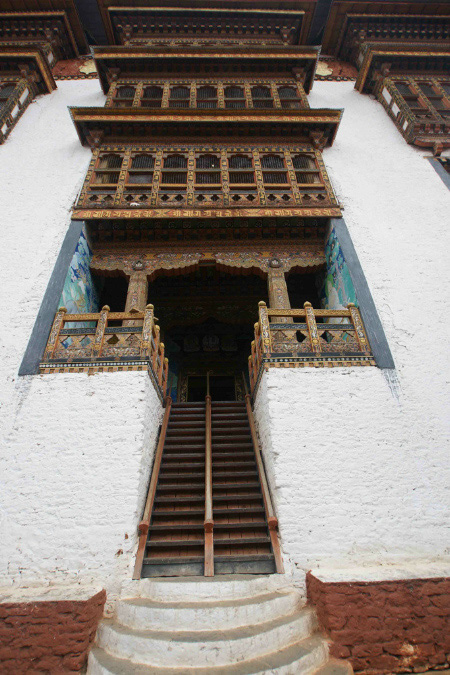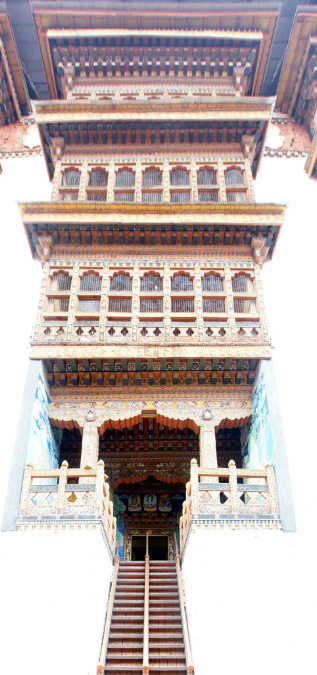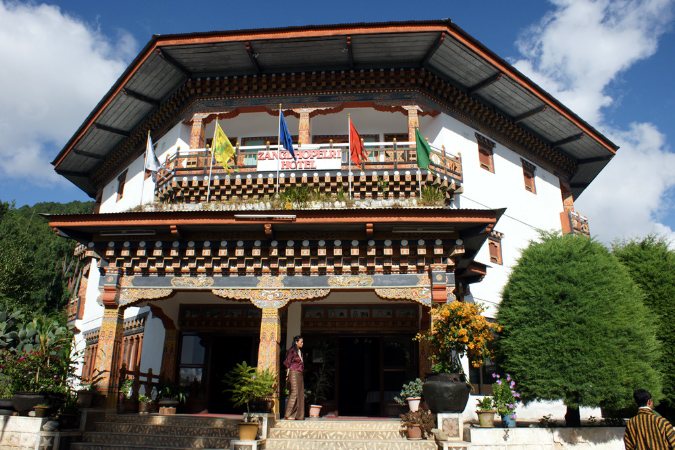|
The three-storey Machen Lhakhang was built out of Cyprus wood with four
entrance pillars intricately embossed with religious symbols in gold and
silver. The inside of the lhakhang has been decorated with intrinsic and
rich murals and frescos depicting the teachings of Lord Buddha. The
images of seven incarnations of the Zhabdrung were also installed in the
lhakhang. An ornate 15-foot Kudung Chhorten was installed, made of
sandalwood and encased in silver and gold and adorned with jewels like
corals, pearls, turquoise, and other precious stones. It was constructed
by 20 craftsmen over four years. The Kuenrey, which was on the verge of
collapse, was reconstructed on a grand scale. This great hall now
features 12 30-foot cyprus pillars adorned in gilded brass plates
embossed with elaborate religious sculpture. In the Kuenrey sits the
main 35-foot image of Buddha Shakyamuni, crafted out of a mixture of
five menjim (precious substances) and medicinal clay. The back wall
carries images of the 16 arhats. The Buddha is flanked, on the right, by
a 28-foot image of Guru Padmasambhava and, on his left, by a 28-foot
image of Zhabdrung Ngawang Namgyal. Along the left wall of the Kuenrey
sit 48 three-foot images of the spiritual masters of the kagyu lineage.
On the right side are 48 three-foot images of dongyu zinpa (lineage
holders).
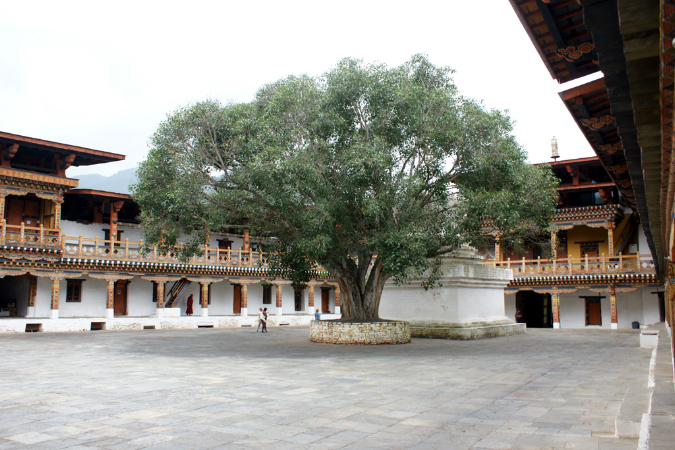
Auf diesem Platz, im Innenhof des Dzongs finden die Festivals statt.
Time and natural elements as well as human weaknesses had thus taken
their toll on this proud edifice. By the late 1980s many lhakhangs were
on the verge of collapse because the wooden structures of the dzong had
decayed. Precious images and manuscripts had been damaged and destroyed
with losses estimated at millions of Ngultrums. It was then that His
Majesty the King commanded the reconstruction of the dzong. Under His
Majesty's personal supervision, Bhutan's centuries-old building and
artistic traditions came together and, over the past 12 years, thousands
of carpenters and wood sculptors, metal and clay sculptors, masons,
painters, fresco experts, electricians, blacksmiths, goldsmiths,
silversmiths, tailors, and monk artisans re-lived history as they worked
on the Punakha Dzong Renovation Project.
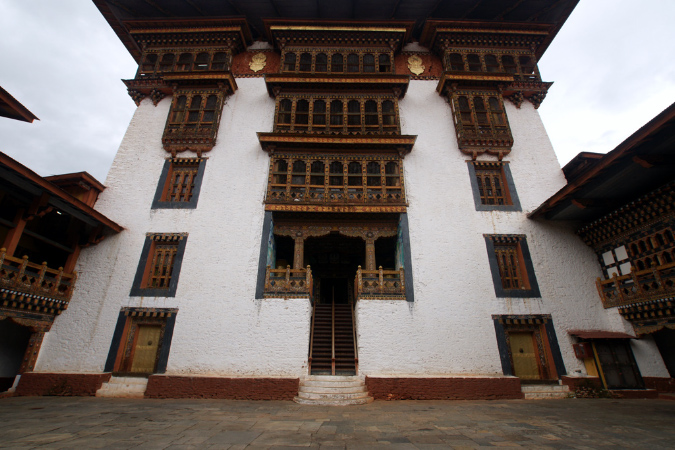
The home ministry was given the overall responsibility with the Tenso
Lapon, Dasho Wangchuk, as site supervisor. Tenso Lapon Dasho Wangchuk is
the recipient of the Druk Thuksey for his outstanding contributions in
the renovation of the Punakha Dzong and restoration of lhakhangs and
monasteries. The five lhakhangs above the Kuenrey were all re-built and
new sacred images installed: Neten Chudrung, Goengkhang, Lhamo, Rigsum
Gompo, and Phurpai Lhakhang. In accordance to prophesy a 10-foot Guru
Dorji Droley image was installed in the Droley Lhakhang facing the
confluence of the Phochu and Mochu rivers. The Tsen Chhorten was
reconstructed as a two-storey building and the Je Khenpo's residence
expanded into a four-room apartment with a choekhang. All the woodwork
of massive beams, joists, pillars, floors, doors and windows - in the
five floors of the Utse was changed, with timber brought in from
different dzongkhags. So were the wooden structures on the roof of the
dukhang. New kitchen and restrooms for the monks were constructed
outside the dzong to reduce the risk of fire. |
|
In 1994 a catastrophic flood damaged the Dzongchung although the Jhou
(Buddha image) was miraculously saved. Originally built in 1374 by the
great sage Dupthop Ngagi Rinchhen, the dzongchung was restored in 1996
and consecrated by His Holiness, Geshe Gueden Rinchhen, the 69th Je
Khenpo. Besides enlarging the plinth area to 1,500 square feet from the
previous 590 square feet a large retaining wall, 25 to 35 feet in
height, was constructed around the Dzongchhung, using stone masonry and
cement mortar. More than 200 new images crafted for the dzong represent
some of the finest masterpieces available in the country. The Shakyamuni
Buddha, Guru Rinpoche, and Zhabdrung Ngawang Namgyal in the Kuenrey, the
life-size gilded images of Mahakala and Pelden Lhamo in the goenkhang,
and dozens of larger-than-life images are unique works of art achieved
through meditative focus and concentration.
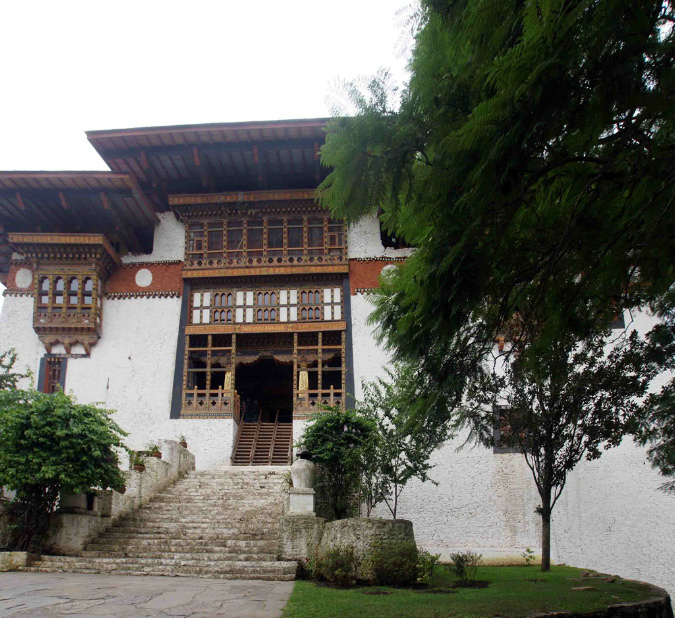
Aufgang in den Dzong
Jede Treppe war für bestimmte Personen bestimmt.
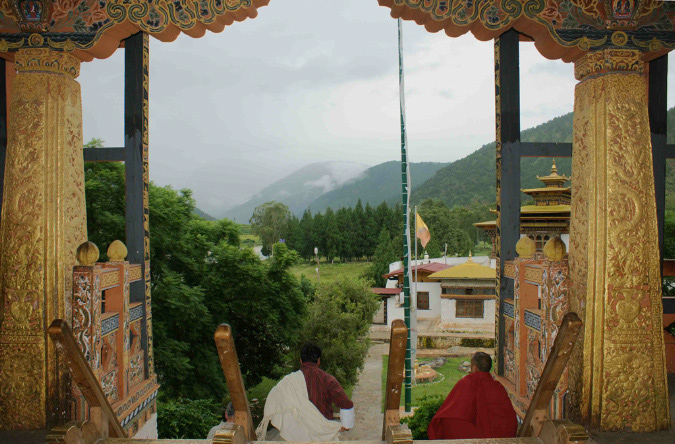
In der Mitte die weltlichen, die äußeren für die Mönche. Hier mit
Beispiel (Ich hoffe, das ist nicht nur Zufall.)
The Yeshey Semba (essence of primordial wisdom deity) for the numerous
lhakhangs, chhortens, altars, and images in the dzong are invaluable
treasures offered by His Majesty the King and the royal family, lams and
trulkus, and devotees from all parts of the country. Punakha Dzong was
the seat of Zhabdrung Ngawang Namgyal's rule during which he unified the
country, protected it from external invasion, strengthened the teachings
of the Dharma, and established the tenets of the Bhutanese identity. On
December 17, 1907, it was in this dzong that the Dratshang, Ponlops and
Dzongpons, on behalf of the Bhutanese population, put their seals on the
historic genja and unanimously elected Gongsar Ugyen Wangchuck as the
first hereditary monarch of Bhutan. With the completion of the project
it has been enriched in religious treasures, in structural endurance,
and in the beauty of traditional Bhutanese architecture and artwork by
the fourth Druk Gyalpo. The Dewachenpoi Phodrang is, today, the sacred
impregnable monument that Guru Rinpoche prophesied and Zhabdrung Ngawang
Namgyal established. The Dratshang performs the consecration ceremony in
the Kuenrey The Pungthang Dewachenpoi Phodrang.
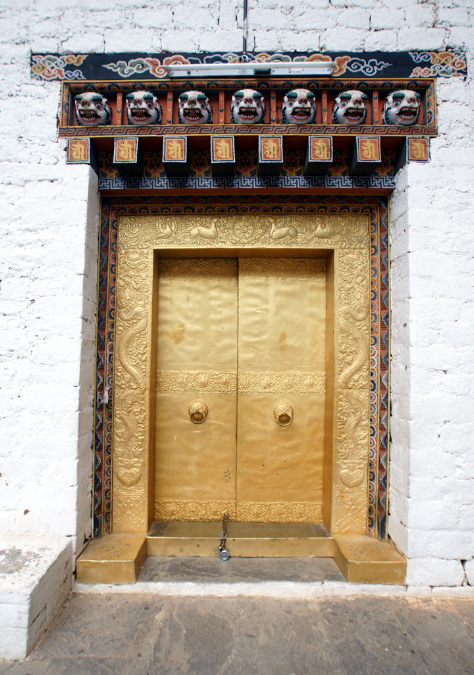
Completely restored as one of the most important monuments of Bhutan’s
religious, cultural, and political history, and now enriched with new
Lhakhangs, more than 200 new religious images, and numerous other
treasures, the Punthang Dewachenpoi Phodrang was sanctified and its pure
spirituality immortalised with the sacred rabney ceremony on the 12th,
13th and 14th day of the third Bhutanese month (May 13, 14 and 15,
2004).
His Holiness the Je Khenpo and the monks of the Dratshang (central monk
body) performed the dechog khorlo dombi kechog to sanctify the majestic
Dzong built on the site of a sacred nye (abode) of dechog khorlo domba,
the supreme yidam (tutelary deity) of Shabdrung Ngawang Namgyal.
The rabney ceremony was attended by His Majesty the King, His Royal
Highness the Crown Prince, Their Majesties the Queens and the royal
family, Lams and Trulkus from all Buddhist traditions in Bhutan,
ministers and senior government officials, officers of the Bhutanese
service forces, ambassadors and dignitaries representing the
international community, and the people of Bhutan.
On May 15, the rabney concluded with the unique Tashi Ngasol ceremony
with His Majesty and His Holiness leading the entire gathering in an
elaborate procession to circumambulate the Dzong. The procession,
representing all life forms, carried the Tashi tagye (eight lucky
signs), Tashi Zegye (eight precious objects), and the Geyse Nga-duen
(seven treasures of a universal King), and offered prayers in the
ultimate celebration of the auspicious occasion.
The religious ceremonies were conducted in the new Kuenrey of the Dzong
where the Dratshang offered the Tashi Ze-gye, the Geyse Na-duen, and the
Ku-Sung-Thuk-Ten Mendrel to His Majesty the King.
For the large gathering that represented all sections of the Bhutanese
population, the rabney of the historic Punakha Dzong was a
re-enforcement of the priorities and values that had survived and
strengthened over the centuries.
The Tshennyi Lopon of the Dratshang said that, as His Majesty and the
royal family, all sections of the government and the people merged in
Punakha, the occasion was an auspicious and significant moment in
Bhutanese history. “The restoration of the Punthang Dewachenpoi Phodrang
established by Shabdrung Ngawang Namgyal to unify the country will
ensure that our nation enjoys peace, stability, and prosperity, and that
the dharma will flourish forever,” he said.
For the elderly people, it was a pilgrimage that was possible only after
several centuries and an opportunity that very few devotees could ever
hope to experience. Seventy-year old Pasa Zom walked all the way from
Laya and, for her, it was worth every step of the five-day journey.
Bidha, 77, of Paro Tsento had always regretted the fact that she had not
been able to afford to go on pilgrimage to India when many of her
friends did so every winter. Not any more. She now believes that she has
received the most sacred blessing that she or any Buddhist could hope
for.
“Our Lam Shabdrung is here,” said Gyeltshen of Shengana. “We are safe
from our enemies. Just as Shabdrung Ngawang Namgyal repelled our
enemies, we will withstand whatever threat we face today.”
The occasion brought Bhutanese history alive for most students. “I
understand that what is happening today is what happened before, as
written in our school books,” said a Class 10 student, Tandin. “The only
difference is that this is so much more colourful, so much more
beautiful. But history will mean much more to me now.”
For the Resident Coordinator of the UN agencies, Renata Dessallien, it
was an “extremely memorable experience”. “I’ve worked all over the world
for the UN over many years,” she said. “This was the most memorable and
spiritual occasion that I’ve had the honour to attend. All the foreign
nationals here were very fortunate to participate in this and witness
such a special event.”
With the government of India having contributed Nu 437 million for the
restoration of the Punakha Dzong, the Talo Monastery, the Dzongchung,
construction of bridges and river protection work after the 1994 floods,
His Majesty the King, on behalf of the government and people of Bhutan,
and His Holiness the Je Khenpo, on behalf of the Central Monk Body,
expressed their deep appreciation to the government and people of India.
The Indian ambassador, Mr K S Jasrotia, who was presented a Buddha image
by the Je Khenpo as a token of Bhutan’s appreciation, said that he found
the solemnity of the occasion overwhelming.
“The function reflects the vitality and vibrance of Bhutan’s religious
and cultural traditions,” he said. “ India and Bhutan have old
historical and cultural ties and the government and people of India feel
privileged and honoured to be associated with this historical occasion
and with the renovation of one of the most sacred dzongs of Bhutan. We
are happy to be associated with a process that is helping to perpetuate
and sustain Bhutan’s rich traditions and customs.”
The ambassador said that the government and people of India were also
happy that their small contribution had been useful. “The renovation of
the Dzong is a monument to Indo-Bhutan cooperation,” he said. “I
congratulate the people of Bhutan and wish them Tashi Delek.” For the
people who were involved in the construction work it was not just a
professional experience, but an opportunity to earn merit and a true
blessing.
The Tenso Lapon, Dasho Wangchuck, said that the reconstruction of the
Punakha Dzong had been a great opportunity for traditional craftsmen
from all parts of the country to learn the skills of the zorig chusum.
It was a revival of this ancient Bhutanese tradition.
“They were able to learn from the handful of real masters in these
ancient crafts like wood carving, masonry, metal work, painting, and
many other skills,” he said. “We now have a new generation of craftsmen
and the zorig chusum tradition is already much stronger than it was a
few years back. In fact, now that we have restored the Punakha Dzong to
its full glory, we are prepared to undertake other major renovation work
on Dzongs and Lhakhangs and other architectural heritage.”
Bhutan is endowed with ancient and historical Dzongs and numerous sacred
Lhakhangs which are centuries old, representing the kingdom’s spiritual
wealth and rich cultural heritage. With the changing times and
modernisation, the traditional skills of the zorig chusum are required
to preserve and maintain these sacred treasures. The Pungthang
Dewachenpoi Phodrang is a national treasure to be preserved and
cherished for the future generations.
|
|
The Punakha Dzong, also known as Pungtang
Dechen Photrang Dzong (meaning “the palace of great happiness or
bliss”)
is the administrative centre of
Punakha dzongkhag in
Punakha,
Bhutan. Constructed by
Zhabdrung (Shabdrung) Ngawang Namgyal in 1637-38,
it is the second oldest and second largest
dzong in Bhutan and one of its most majestic structures.
The Dzong houses the sacred relics of the southern
Drukpa Kagyu school including the Rangjung Kasarpani, and the sacred
remains of
Zhabdrung Ngawang Namgyal and
Terton Padma Lingpa. Punakha Dzong was the administrative centre and
the seat of the
Government of Bhutan until 1955, when the capital was moved to
Thimphu.
On the hill above Rinpung Dzong is a seven storied the
watchtower fortress or Ta Dzong built in 1649. In 1968 this was
established as the home of the
National Museum of Bhutan.
Just below Rinpung Dzong is a traditional covered
cantilever bridge.
The Dzong is located at the
confluence of the Pho Chhu (father) and
Mo Chhu (mother) rivers in the Punakha–Wangdue valley. The source of
the Mo chu river is in the northern hills of Lighsi and Laya in Bhutan,
and in
Tibet. The Po Chu River is fed by glaciers in the Lunana region of
the Punakha valley. After the confluence of these two rivers, the main
river is known as Puna Tsang chu or
Sankosh River and flows down through
Wangdiphodrang, crosses the Bhutan–India border at Kalikhola and
eventually meets the
Brahmaputra River.
In view of the healthy
climate in the region, Punakha is the winter capital of Bhutan. The head
of the clergy of Bhutan with his entourage of monks spend the winter in
this dzong.
Lilac coloured
jacaranda trees grow around the dzong during the spring season.
According to a local
legend, the sage
Guru Rinpoche prophesized that “a person named Namgyal will arrive
at a hill that looks like an elephant”.
Zhamdrup Namgyal found the peak of the hill, which appeared in the
shape of trunk of an elephant as prophesized, and built the dzong in
1637-38.
Another legend tells how Zowe Palep, the architect, had a vision in a
dream after the Zhamdrup Namgyal ordered him to sleep under a small
structure which contained a statue of the Buddha, known as Dzong Chug
(small dzong). In his dream, prompted by the psychic powers of the
Zhamdrup, he had a clear vision of a palace for Guru Rinpoche. The
vision was imprinted on the architect's mind, enabling him to conceive
the plan for the Dzong without putting the vision on paper and to built
it.
On
the basis of the dream vision of the architect, the building of the
Dzong was started in 1637 and completed in 1638, at the place where the
Dzong Chug (small dzong), had existed. During this period,
Zhabdrung Ngawang Namgyal became the first religious-political
leader, following his concerted efforts to unify the country into one
unit as Bhutan. The dzong was consecrated in the name of Pungthang
Dechen Phodrang. In 1639, a commemorative chapel was erected to house
the arms seized from the
Tibetans who were defeated by the Bhutanese on this spot. Zhabdrung
also set up a monastic order with 600 monks (brought from Cheri Gompa of
upper
Thimpu valley) and he lived here till his death. The spire at the
top of the utse (the dzong’s central tower or the main tower)
was added in 1676 by Gyaltsen Tenzin Rabgye–the abbot of the dzong.
Further additions were made during the period 1744 to 1763, when Sherab
Wangchuk was the ruler. A large
Thangka known as chenma (great) thoundral of the
Zhabdrung was donated to the Dzong by the Desi (ruler). This thangka is
displayed during the
Tsechu festival held once a year here. The
Seventh Dalai Lama donated the brass roof for the dzong.
Wangchuk Monarchy is
currently ruling the country. This monarchy was established in 1907. The
same year, Punakha Dzong was the site of the coronation of
Ugyen Wangchuck (or Deb Nagpo) as the first
King of Bhutan. At that time, Punakha was the capital of Bhutan.
Three years later, a treaty was signed at Punakha whereby the
British agreed not to interfere in
Bhutanese internal affairs and Bhutan allowed
Britain to direct its foreign affairs.
From 1744 to 1763, the dzong was enlarged substantially during the rule
of the 13th desi, when Sherab Wangchuk was the chief
abbot of Bhutan.
Several fires between 1750 and 1849 caused damages to the Dzong. In the
1897 earthquake, the dzong was severely damaged and also suffered
numerous fires. In 1986, the dzong was partially destroyed by fire.
The Dzong is part of the
Drukpa school of
Mahayana Buddhism in Bhutan. It is the second oldest and most
majestic dzong in Bhutan built at the orders of
Zhabdrung Ngawang Namgyal.
It is a six-storied structure with a central tower or Utse at an average
elevation of 1,200 metres (3,900 ft) with a scenic, mountainous
background. The materials used in building the Dzong consisted of
compacted earth, stones and timber in doors and windows. The Dzong was
constructed as an “embodiment of Buddhist values” and was one of the 16
dzongs built by the Shabdrong during his rule from 1594 to 1691. The
Dzong measures 180 metres (590 ft) in length with a width of 72 metres
(236 ft) and has three docheys (courtyards). The defensive
fortifications built in the dzong to protect it from enemy attacks
consist of a steep wooden draw stairway and a heavy wooden door that is
closed at night. After the Dzong suffered damages due to a fire, a large
prayer hall was added in 1986.
Administrative offices of the dzong, a very large white washed
chorten and a
bodhi tree are located in the first courtyard. Also seen in the same
courtyard, on the far left, are a mound of stones and a chapel dedicated
to the queen of
nāgas (snake spirits). The residential quarters of monks are located
in the second courtyard, with the utse intervening in between the
first and the second courtyards. There are two historic halls in this
courtyard; one of Ugyen Wangchuk, who subsequently became the King and
another hall where the King was decorated in 1905 with the Order of the
Knight Commander of the
Indian Empire by John Claude White. The third courtyard is at the
southern most end of the dzong where the remains of Pema Lingpa and
Zhanbdrung Ngawang Namgyal are preserved.Machey
Lakhang ('machey' literally means "sacred embalmed body")
in the third courtyard has the well preserved embalmed body of Zhabdrung.
This Lakhang was rebuilt in 1995. The casket containing the embalmed
body is not opened at all. However, the place is visited by the King and
the Je Khenpo mainly to seek blessings before assuming their offices.
Flash floods, resulting from
glacial lake outburst flooding in the upper reaches of the valley,
are a common occurrence in the Mo Chu and Po Chu rivers, and in the
past, caused flooding and damage to the Dzong, especially in 1957, 1960
and 1994. Fires and earthquakes have also further added to the problem.
In 1996, flash floods in the Po Chu river damaged the large
chorten in the precincts of the Dzong and caused several deaths.
After a major refurbishing work carried out in the "zorig
chusum tradition" (an ancient tradition of crafts in wood carving, masonry,
metal work, painting, and several other skills), the Dzong now has
several new Lhakhangs, over 200 new religious images, and several other
treasures. A consecration ceremony known as the “Rabney ceremony”
performed by His Holiness the Je Khenpo and the monks of the Dratshang
(central monk body) was held from May 13 to 15, 2004, corresponding to
the 12th to 14th day of the third Bhutanese month. The restoration works
were largely funded by the
Government of India and the Dzong stands fully restored to its past
glory.
After complete restoration of the Dzong to its old glory, notable
images, statues and thangkas are displayed in the Dzong. These include
murals depicting life story of Buddha done during the rule of the second
druk desi. Large gilded statues of Buddha, Guru Rinpoche and Zhabdrung
which belong to mid 18th century, and gilded panels on pillars are also
here.
A covered wooden
cantilever bridge crossing the Mo Chu river was built together with
the Dzong in the 17th century. This bridge was washed away by a flash
flood in 1957. In 2006, work started on a new wooden cantilever bridge
in the traditional style, with a free span of 55 metres (180 ft). It was
completed in 2008.In
2008, after completion of the cantilever bridge, the new bridge was
hailed as a celebration of “100 years of Wangchuck Monarchy in 2008 and
to the coronation of His Majesty King Jigme Khesar Namgyel Wangchuck in
the Punakha Dzong”.Thus, the Dzong has been the venue for coronation of all the kings of
Bhutan.
A memorial honouring the 23 people who died in the dzong in the glacial
floods in 1994 has also been erected just outside the dzong
|
